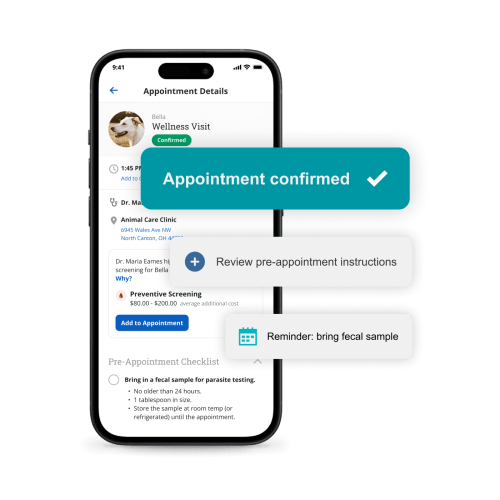Streamlining Veterinary Appointments: Optimizing Scheduling and Workflows

Scheduling and workflow significantly impact daily veterinary clinic operations. A poorly organized schedule can hamper efficiency, leading to cranky, waiting clients and overworked team members. A smooth workflow is key to meeting client needs, especially when veterinary medicine is in high demand and credentialed team members are in short supply. Here are a few strategies to improve your clinic’s scheduling efficiency and determine what works best for your organization and culture.
1. Implement advanced scheduling solutions
Advanced veterinary software can help overhaul your scheduling system. Look for software that supports online client booking, which can help reduce calls and ease your front office team’s responsibility to ensure appropriate bookings. Set up customized online booking to automatically populate your calendar. For example, allow only two sick pet appointments per hour, add extra time for new patients, or leave same-day slots open for urgent care. Additionally, software with integrated client communication tools can send automatic appointment reminders and instructions via email or text, reducing no-shows and latecomers.
2. Optimize appointment length and schedule organization
Different appointment types require various time allocations, but the time allowed for each pet depends on staffing and space. Clinics with multiple technicians and at least four exam rooms per veterinarian can support 15- to 20-minute time slots. The support team conducts check-ins, diagnostics, estimates, treatment orders, education, discharges, and check-outs, while the veterinarian moves quickly from room to room. Consider allowing extra time for sick pets, new patients, chatty clients, or other special circumstances if your clinic is smaller with fewer support staff members. Other considerations for each day’s schedule include buffer or “catch-up” blocks, emergency or urgent care slots, lunch breaks, phone calls, drop-off exams, surgery check-ins, surgeries, and discharges.
3. Prepare clients with better communication
Effective communication ensures clients are well-informed about the scheduling process and what their upcoming visit will involve. Use client communication platforms to send email or text reminders, wellness recommendations, consent forms, and cost estimates, so the team needs less time to review them during in-person visits.
4. Use data analytics to identify problem areas
Data analytics pulled from your practice software can provide valuable insights into clinic operations, helping you identify trends, peak times, and areas for improvement. Analyzing appointment data can help you make informed decisions about scheduling and resource allocation, so you can book more staff during the busiest hours or make fewer appointments at strategic times.
5. Hire, schedule, and train staff appropriately
The more veterinary technicians on your team, the smoother your days. With more techs and other support staff, your schedule can support more patients, and you will have fewer bottlenecks. If finding qualified, credentialed team members is difficult, train your own! Put your existing non-credentialed staff through a distance-learning program to gain certification, which will elevate your practice to a new level and relieve the veterinarians’ task burdens.
6. Get feedback from the team
If you aren’t sure what factors are causing issues in the schedule or workflow, go to the floor staff who are experiencing the problems first-hand. Ask clinical team members, including support staff and veterinarians, to identify the tasks causing bottlenecks and frustrations, and then find solutions together. Be open and willing to try new ideas, such as revamping a protocol, altering veterinarian hours, or staggering work schedules. Then, follow-up a few weeks later to determine the success of the changes you implemented. When you solicit and follow through on feedback, you get the bonus of creating a safe workplace where employees feel heard.
Optimizing appointment scheduling and workflows in veterinary clinics requires careful analysis of the underlying problems and a team effort to find solutions. Embracing modern veterinary software can help you achieve practice efficiency goals by providing the tools necessary for effective workflow management. Additionally, rearranging schedules and blocking all tasks on the calendar relieves the chaos. Each team is different, but all teams must work together to determine the best strategies to optimize practice efficiency.




